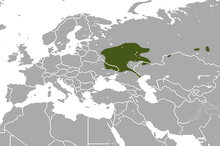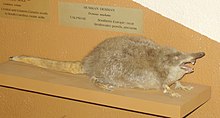| Revision as of 03:15, 27 August 2017 editMaias (talk | contribs)Autopatrolled, Extended confirmed users, Pending changes reviewers115,805 edits removed Category:Animals described in 1758; added Category:Mammals described in 1758 using HotCat← Previous edit | Revision as of 21:10, 15 November 2017 edit undoTom.Reding (talk | contribs)Autopatrolled, Extended confirmed users, Page movers, Template editors3,887,355 editsm →External links: +{{Taxonbar}} to pages with a matching WikiData IUCN ID; WP:GenFixes on; using AWBNext edit → | ||
| Line 39: | Line 39: | ||
| ==External links== | ==External links== | ||
| *{{ |
*{{Commons category-inline|Desmana moschata}} | ||
| *{{wikispecies-inline|Desmana moschata}} | *{{wikispecies-inline|Desmana moschata}} | ||
| * ARKive - | * ARKive - | ||
| {{Soricomorpha|T.}} | {{Soricomorpha|T.}} | ||
| {{Taxonbar}} | |||
| ] | ] | ||
Revision as of 21:10, 15 November 2017
| Russian desman | |
|---|---|

| |
| Conservation status | |
 Endangered (IUCN 3.1) | |
| Scientific classification | |
| Kingdom: | Animalia |
| Phylum: | Chordata |
| Class: | Mammalia |
| Order: | Soricomorpha |
| Family: | Talpidae |
| Subfamily: | Talpinae |
| Tribe: | Desmanini |
| Genus: | Desmana Güldenstädt, 1777 |
| Species: | D. moschata |
| Binomial name | |
| Desmana moschata (Linnaeus, 1758) | |

| |
| Russian desman range | |
The Russian desman (Desmana moschata) (Template:Lang-ru vykhukhol') is a small semiaquatic mammal that inhabits the Volga, Don and Ural River basins in Russia, Ukraine and Kazakhstan. It constructs burrows into the banks of ponds and slow-moving streams, but prefers small, overgrown ponds with abundance of insects, crayfish and amphibians. The Russian desman often lives in small (usually not related) groups of two to five animals, and appears to have a complex (but largely unstudied) communication and social system.
The Russian desman is one of two surviving species of the tribe Desmanini, the other being the Pyrenean desman. Despite its outward similarity to muskrats (a rodent), the Russian desman is actually part of the mole family Talpidae in the order Soricomorpha. Like other moles, it is functionally blind and obtains much of its sensory input from the touch-sensitive Eimer's organs at the end of its long, bilobed snout. However, the hind feet are webbed and the tail is laterally flattened —specializations for its aquatic habitat. The body is 18 to 21 cm (7.1 to 8.3 in) long while the tail is 17 to 20 cm (6.7 to 7.9 in) in length. Easily the largest species of mole, it weighs 400 to 520 g (14 to 18 oz).

Decidedly rich and thick in nature, desman fur used to be highly sought after by the fur trade. Consequently, the Russian desman is now a protected species under Russian law. However, due to loss of habitat (farming), water pollution, illegal fishing nets, and the introduction of non-native species (e.g., muskrat), population levels continue to decline. In the mid-1970s, an estimated 70,000 desmans were left in the wild; by 2004, the figure was only 35,000. However, in some Russian regions, the number of desmans appears to be increasing.
References
- Hutterer, R. (2005). "Order Soricomorpha". In Wilson, D.E.; Reeder, D.M (eds.). Mammal Species of the World: A Taxonomic and Geographic Reference (3rd ed.). Johns Hopkins University Press. p. 303. ISBN 978-0-8018-8221-0. OCLC 62265494.
- Template:IUCN2012.1 Listed as Vulnerable A2bc+4bc.
- Morelle, Rebecca (4 September 2012). "Pyrenean desman: On the trail of Europe's weirdest beast". BBC News.
- "Russians rally for water mammal". BBC News. 9 June 2006.
External links
 Media related to Desmana moschata at Wikimedia Commons
Media related to Desmana moschata at Wikimedia Commons Data related to Desmana moschata at Wikispecies
Data related to Desmana moschata at Wikispecies- ARKive - images and movies of the Russian desman (Desmana moschata)
| Taxon identifiers | |
|---|---|
| Desmana moschata |
|
This article about a eulipotyphlan is a stub. You can help Misplaced Pages by expanding it. |
This Russia-related article is a stub. You can help Misplaced Pages by expanding it. |